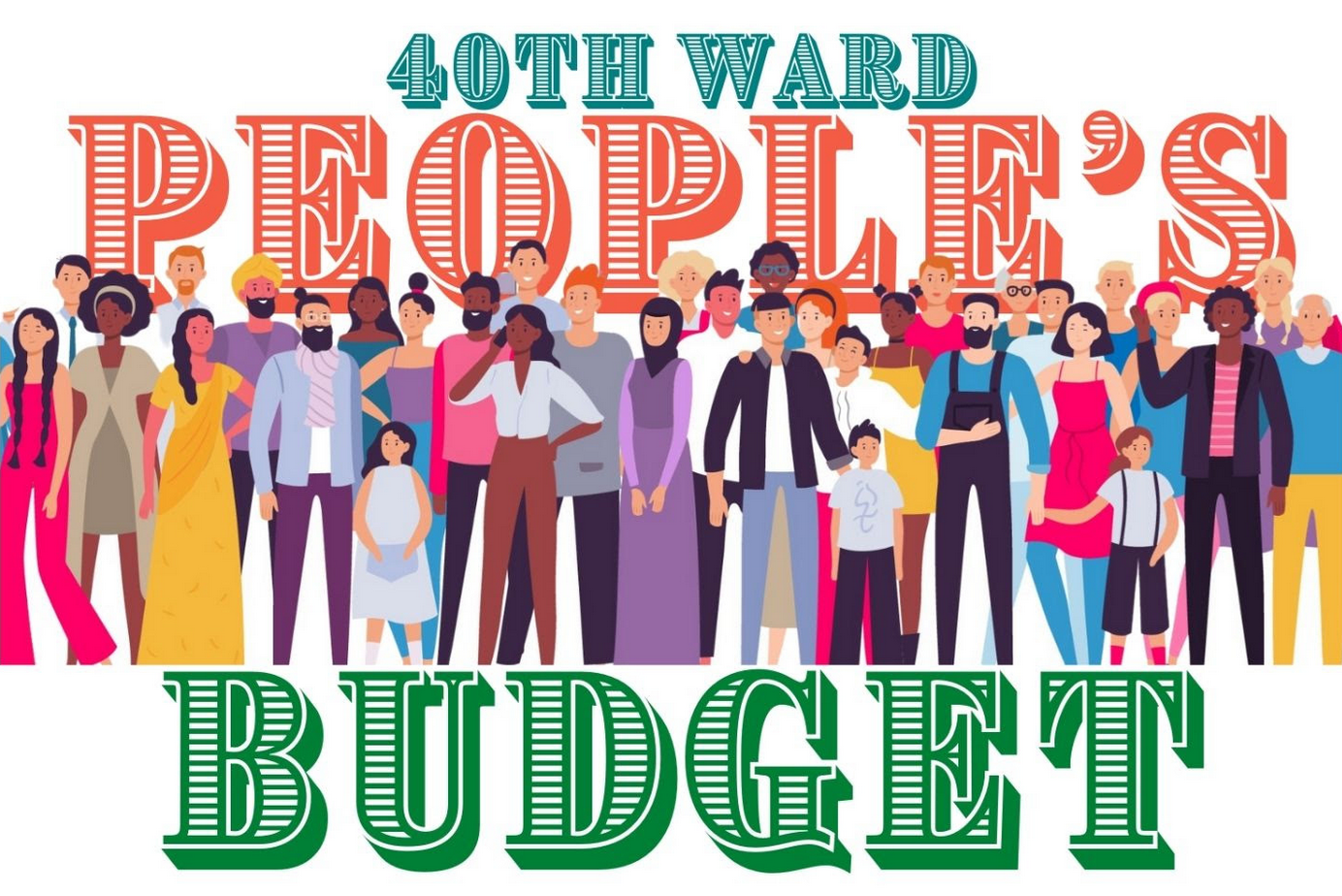
Thank you so much to all who participated in our Participatory Budgeting (PB) process– the People’s Budget– this past year. By participating you helped decide how to spend public funds on community projects in the 40th Ward. We are pleased to share that we had close to 1,500 ballots entered for the 2022-2023 cycle!
How does Participatory Budgeting Work– A Reminder
On September 1st 2022 we kicked off our fourth ever PB season! The timeline for our 2022-2023 cycle is below.
September: Idea Collection, Committee Creation
Neighbors brainstormed and submitted Special Project ideas they wanted to see in their communities and applications were accepted to join the PB Committee. We had three in-person idea solicitation events, one each at Warren Park, Ainslie Arts Plaza and Green Briar Park, as well as rolling online submissions.
October: Project Development & Vetting
The PB Committee reviewed and vetted Special Project ideas.
Neighbors applied to be on the PB Committee and it was composed of 12 members who assessed ideas submitted by neighbors. Each submitted Special Project was scored based on the five factors below. The PB Committee then picked the top five projects that constituents saw on the final ballot.
- Sustainability: Does the project benefit our natural environment either directly or indirectly? Will this project have positive short term or long term impacts on the environment on a small scale or a large climate related scale?
- Equity: How many people will this serve? Will it serve only a certain portion of the community or will it benefit many different groups? What benefits will the community gain from implementing this project?
- Community Value: What benefits do you think this project has for the community? Would these be short term or long term benefits? Would these projects improve the 40th ward and build on work to make the ward not only a wonderful place to live but a destination for folks around the city?)
- Feasibility: Does this project seem like it would be achievable? If the proposal sounds like a long term project, is it a project that would be worth the time it takes to implement? Do you think the positives of this proposal outweigh the negative impacts it may have?
- Solves a clear problem: Will this project solve an issue facing our community? How effective do you think this solution is?
November – December: Voting
Residents of the 40th Ward voted on how much of the $1 Million in menu funds go towards Repairs, and how much should go towards Special Projects. We had five in-person voting locations: Budlong Woods Library, River Park Fieldhouse, Warren Park Fieldhouse, Peterson Plaza Apartment, Schneider Apartments, G & A Senior Development.
The first part of the PB ballot consists of having constituents vote on what percentage of the $1 million in menu funding, allocated to us yearly by the Department of Transportation, they want to go toward Repairs (like street resurfacing and fixing sidewalks) versus special projects (like permanent pedestrian infrastructure projects).
In the second part of the PB ballot, neighbors used rank choice voting to rank the Special Projects from most to least favorable. The Special Projects listed on the ballot were all submitted by neighbors, and then vetted and refined by the 40th Ward PB committee.
January – September: Final Estimation, Coordination and Construction
The 40th Ward Office coordinates with the appropriate agencies and departments to make the infrastructure upgrades YOU voted on! On the repairs side, we take a look at all of the repairs submitted through our repair form. Ward menu repairs are infrastructure fixes (eg. fixing sidewalks, resurfacing streets, curb & gutter repairs, green alleys, etc.). We accept potential menu repair projects on a rolling basis to supplement our own surveying. If there is a repair in your neighborhood that you’d like us to consider please fill out this form. We will follow up if the repair project is approved. For special projects, we work with CDOT or the relevant department to get a specific estimate, approve plans for implementation, and keep our neighbors updated every step of the project until completion.
And Now… The Results!
The weighted average percentage that neighbors voted to go to Repairs was 58%. That means 58% ($580,000) will be used on Repairs and 40% ($420,000) will be used on Special Projects.
The Special Projects voted on are listed below from most to least popular:
- Western Ave Pedestrianization ($200,000)
- Left Turn Signal at Foster and Damen ($150,000)
- Contraflow Bike Lanes on N Rockwell St from Foster Ave to Gregory St and Foster Ave to Gregory St ($300,000)
- Bicycle Repair Stations ($50,000)
- Curb Extensions and Bryn Mawr and Francisco ( $50,000)
After paying for the first two most popular projects outright, we are left with $70,000. This means that unfortunately, we are not able to pay for the third most popular project (Contraflow Bike Lanes on N Rockwell St). With the remainder of the funds we will fund the fourth most popular project, installing Bicycle Repair Stations. However, we will work with the CDOT bike team to see if we can find alternative funding for the contraflow bike lanes.
Based on the allocated $420,000, the Special Projects selected this year are:
- Western Ave Pedestrianization: Fixing sidewalks from Hollywood to Thorndale on the east side of Western Avenue plus the addition of bump outs at Western and Ardmore
- Left Turn Signal at Foster and Damen, on Foster: Multiple neighbors submitted requests for this project and have the difficulty and dangerous nature of turning left from Foster Ave to Damen Ave.
- Bike Repair Stations: Installation of bicycle repair stations in pedestrian plazas, parks, and community areas with high bike traffic